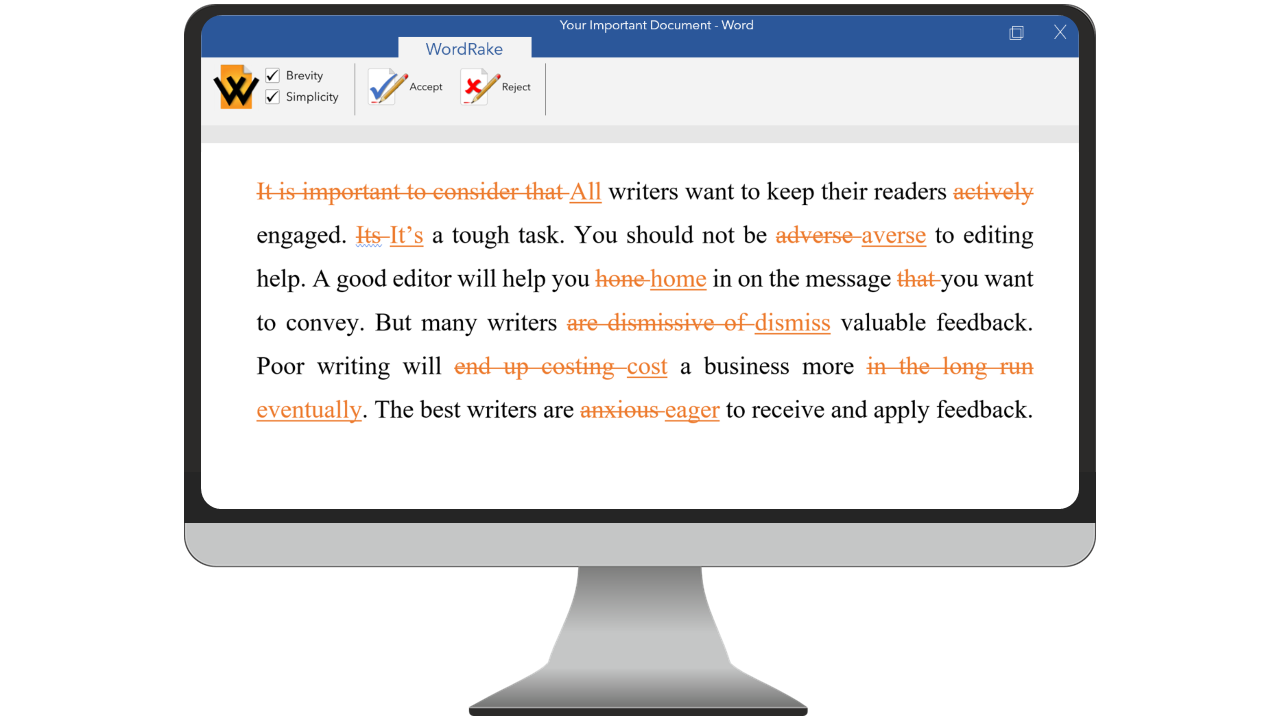See also followup: I Put WordRake’s New Version 4.0 to the Test Against the Supreme Court’s Second Amendment Opinion in New York State Rifle & Pistol Association.
The legal editing software WordRake is today releasing a new version 4.0 that expands its functionality, adds new pricing options for less-frequent users, and introduces a new Simplicity editing mode for simplifying complex language.
WordRake President Scott Johns calls this a “massive update” in which WordRake has “expanded functionality, dramatically increased editing algorithm quantity and quality, eliminated license keys for renewals, and lowered the barrier to entry for new users.”
Today I will tell you about the new version. Tomorrow, I will publish a brief hands-on review after testing an advance copy of the software.
WordRake now has two editing modes: Brevity and Simplicity. Brevity does what WordRake has always done, which is suggest edits that can make a document more concise.
The new Simplicity mode was inspired by a 2010 federal law, the Plain Writing Act of 2010, which requires federal government entities to use “clear government communication that the public can understand and use.”
“The Act inspired us to take WordRake a step further with a unique functionality that would help government agencies communicate more effectively with their readers,” said Gary Kinder, founder of WordRake.
Read about WordRake in the LawNext Legal Technology Directory.
Choice of Editing Mode
As I have explained before, WordRake is an editing and proofreading add-in for Microsoft Word and Outlook that allows users to “Rake” a document for suggested edits to enhance readability.
With this new release, before beginning the Rake process, the user selects to use either the Brevity or Simplicity mode, or both.

The new Simplicity mode makes suggestions designed to simplify complex language. WordRake says it converts jargon, bureaucratic language and difficult words into words that are more familiar.
“Plain language isn’t dumbing down,” said Ivy B. Grey, vice president of WordRake. “It’s improving communication by clarifying and streamlining. It goes beyond word choice to include document design and user testing.”
WordRake says that this new version also includes extensive upgrades and refinements to its existing editing algorithms — the second such update this year.
Grey said this version introduces hundreds of new editing algorithms; fine-tunes editing suggestions for legal terminology; implements more sophisticated algorithms for relative clauses; and introduces more efficient edits for lengthy sentences involving two or more verbs.
New Subscription Options
In addition to the new editing mode, WordRake 4.0 adds new subscription options. Previously, WordRake offered only one-year and three-year licenses, with the one-year license costing $129 for just the Word add-in or $199 for both the Word and Outlook add-ins.
Now, WordRake is changing to a subscription model, offering both monthly and annual subscriptions. The monthly subscription is designed to accommodate those who do not write often. It costs $17 for Word or $24 for both Word and Outlook.
The annual price remains unchanged, but now is converted to a subscription instead of a license, which means that it will renew automatically each year.
For anyone who prefers a one-year non-renewing license, WordRake will still offer that.
Customers who choose the subscription model will no longer be required to enter a new license key each year.
Current WordRake customers with version 3.85 or later may upgrade to version 4.0 by checking for updates from the Help menu within the app. All WordRake users may download the update from these links:
- WordRake for Word on Mac: https://www.wordrake.com/update-word-mac.
- WordRake for Word on Windows: https://www.wordrake.com/update-word-pc.
- WordRake for Outlook on Windows: https://www.wordrake.com/update-outlook-pc.
Anyone interested in trying WordRake may download a seven-day free trial here, even if you have tried an earlier version of WordRake.
WordRake gave me an advance copy of the new software. In a post tomorrow, I will put it to the editing test.
 Robert Ambrogi Blog
Robert Ambrogi Blog